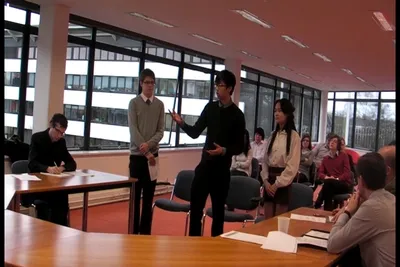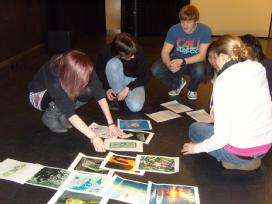Real World Chemistry
Context
In 2010-11, building on the success of the first workshop, the OSL team extended its collaboration with Chemistry into a second initiative, ‘Real World Chemistry’. This was aimed at students who wanted to develop their professional skills and think about how to communicate the political, economic and social applications of Chemistry to different audiences. We also anticipated that once piloted this format might work across other disciplines as a ‘real world’ paradigm.
From a methodological perspective we agreed, in keeping with the precedent of the Periodic Table workshops, that the subject-specific content level should be high to ensure the students’ professional skills were developed in a realistic fashion. Given that many workshops which aim to develop professional skills are run in isolation from academic departments, this was an opportunity to present an alternative working model in which the students improve their communication skills by presenting realistic and academically informed content. We endeavoured to achieve this, as the session plans show, by asking the students to do some research into a ‘real world’ issue to learn about the Chemistry behind the issue, and consider how to present it to a mixed audience of Chemistry specialists and non-specialists.
Method
Session 1
Theory-Building is a staple of the OSL methodology. The facilitator prepares sets of themed slides (around 15 slides is a good number). The slides might contain associated images or text but it is important that the links between them are not too obvious so the participants have room for creative interpretation. On this occasion our theme was the political, economic and social contexts of Chemistry. The group is divided into two teams for this exercise, each team receiving an identical set of 15 slides. The teams have 30 minutes to discuss and arrange the slides in the open space according to narrative or thematic associations, whilst the facilitator responds to queries about the content of some of the images. Once each team has interpreted the other team’s arrangements we convene a plenary on thematic choices –how the Chemistry was interpreted- as well as formal choices –how the Chemistry was expressed.
Real World Scenarios: These were crucial to the overall cohesion of the Real World Chemistry collaboration. We divided the group so that we had teams comprising three students. Each team received a chemistry problem and a real world scenario: they were expected to research the problem together and present their findings in their ‘real world’ roles to a panel of experts and non-experts in session 3. This was content heavy material developed from the expertise of the chemistry staff. Here is a sample of the ‘Real World’ scenarios considered:
1. You trained in food additives after leaving Warwick and now work for a medium-sized firm E-all which supplies additives such as E385 (calcium disodium EDTA) for use in the salad dressings sold by the well-known supermarket chain AsCo. The Managing Dirctor of AsCo has invited you to address his Board. They have had complaints from customers that E385 ruins the flavour of the dressings. You will need to explain to the Board why E385 is used in the dressings and whether there is a suitable alternative. Will this bring new or lose existing business?
2. The Government is considering heavily incentivising the usage of electric cars. These rely upon lithium ion batteries. Your task is to provide a short explanation of how a Li ion battery works and why they are better than traditional lead-acid batteries. You must also present an explanation of how lithium is made, which countries produce it and whether it is likely that these batteries will become more scarce and expensive with time. You are to assist the Government to reach an understanding of whether it would be foolish to invest heavily in electric vehicle technology as it stands today.
3. Present to the board of a smart phone manufacturer why it may be necessary to find an alternative coating for the screens of these devices to that of indium tin oxide. Explain to them what ITO is, how it works, its limitations and an assessment of the likely impact China’s decision to reduce the export of rare earth elements upon company profits.
4. A company of venture capitalists are paying you as a consultant to advise them whether a firm that manufactures superconducting electromagnets is likely to be a good investment. You are to present an account of how such devices work, what they are used for and, critically, whether the helium they use for cooling is likely to become scarce over the next 20 years. (Nick Barker and Peter Sadler)
Session 2
The first part of this session focused on presence and body language using kinaesethetic techniques and status games. The second part provided an opportunity for the students to receive guidance on their ongoing research projects and further prepare for their presentations.
Session 3

Key to the success of this session was that it took place in an intimidating and realistic setting, We reserved a university boardroom and gathered together a diverse panel of experts and non-experts. This included a member of the OSL team, an academic from the Chemistry department, a member of the Student Careers and Skills team and two external industry figures. Each team had 15 minutes to present their research and 5 minutes to field questions from the panel.
At the end of the session there was an opportunity for feedback from the panel. This allowed some of the issues implicit throughout the presentations to be brought out more fully. One theme which emerged strongly was the requirement that accessible commercial arguments be made in conjunction with more detailed technical explanations. The point of the real-world scenario was that an argument had to be made and justified on more than one ground. That the winning team was commended for using a physical prop –a 3D model of a molecular structure– was telling in this respect: it spoke to each panel member on a different level. The non-specialists on the panel felt they could follow the thread of explanation better as a result of this visual and tactile prompt. This showed an excellent level of awareness of presentation style and audience.
Findings
All 12 students involved said they would recommend the sessions to other students and expressed an equal interest in experiencing more OSL events themselves. We also asked them to reflect more generally on OSL in the context of other university teaching methods. Everyone agreed that it was valuable to use a variety of teaching methods, 11 out of 12 said that OSL offered a distinctive way of learning about their subject, and all 12 agreed that these session had helped them think about the application of what they learned in lectures. When we asked which skills they felt these sessions had helped develop, as well as the more expected answer of presentation skills, critical skills figured prominently. This is borne out by the comments which valued learning to present to different audiences, adaptability, and the application of academic knowledge.
What will you take away from the sessions?
How the Chemistry in our lectures applies to the real world and due to the pressure to do well we researched, nor only on what we were asked to do but on the background, other areas that are related to it.”
How the things that we learn in lectures can be applied to real world situations and more about the economic side of the chemistry we learn.”
Professor Peter Sadler who had observed and participated in all of three sessions was impressed by the students’ teamwork. He also concurred on the issue of academic content:
there was real hard chemistry –they did learn a lot more about lithium batteries, about helium, about food additives and so on. They’ll probably remember the science because of the way they had to present it. This is something we’ll be able to carry over into other areas to improve learning skills in general”
Research interview with the Chemistry Lead learners (audio)
Chemistry and OSL: slideshow presentation

